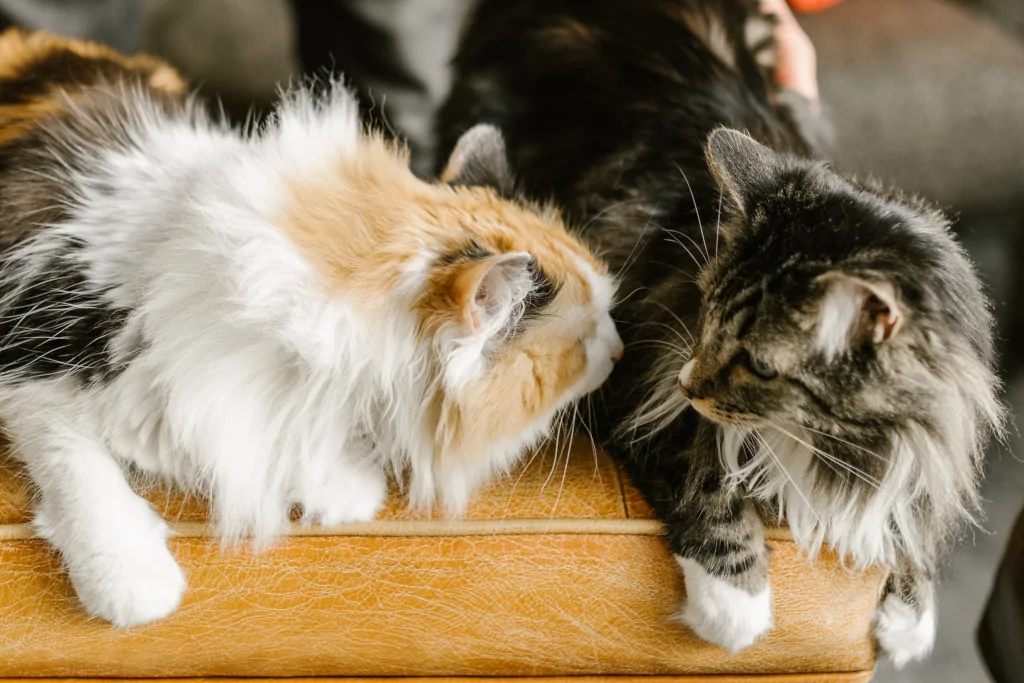Disclosure: We may earn a commission from helpful, relevant links in our content. No cost to you. See our privacy policy.
Introducing a new cat to your home can be a daunting experience, especially when you already have a male cat ruling the roost.
Questions like “Will they get along?” and “Can I prevent them from fighting?” are bound to keep you up at night.
Fear not, cat lovers! In this comprehensive guide, we’ll cover everything from understanding the male cat dynamic to creating an environment that fosters feline friendship.
So, brace yourself for a cat-pact guide that will have you purring with confidence in no time.

The Male Cat Dynamic
Understanding the male cat dynamic is essential when you’re planning to bring home a second male feline.
Male cats, also known as toms, can be territorial and may display dominance when sharing their space with another cat.
However, they can also form strong friendships and social bonds, making it entirely possible for two male cats to live together in harmony.
Factors Influencing Cat Compatibility
Several factors come into play when determining the compatibility of your feline friends. These include:
- Personality. Just like humans, cats have individual personalities. Some may be more laid-back, while others could be more assertive. It’s crucial to consider the temperament of both cats when introducing them.
- Age. Cats of similar ages may have an easier time adjusting to each other, as they have comparable energy levels and interests. However, age is not a deal-breaker, and cats with an age difference can still form lasting friendships.
- Socialization. Cats that have been socialized from a young age with other cats or animals are more likely to accept a new companion.
By keeping these factors in mind, you’ll be better prepared to create an environment where your cats can thrive together. Stay tuned for tips on setting up success with the introduction process and fostering a peaceful coexistence.
The Introduction Process: Setting Up Success
To set the stage for a harmonious relationship between your two male cats, follow these steps to ensure a smooth and successful introduction process:
- Separate spaces. Before bringing home the new cat, set up separate spaces for each feline, complete with food, water, litter boxes, and hiding spots. This will give both cats time to settle and adjust to their respective environments.
- Gradual exposure. Start by introducing your cats to each other’s scent. Exchange bedding or toys between the two spaces to help them get used to each other’s smells without the stress of a face-to-face encounter.
- Controlled meetings. Once both cats seem comfortable with the scents, proceed with short, supervised meetings. Use a baby gate or a screen to allow them to see and smell each other while maintaining a barrier. Keep these interactions brief and positive, gradually increasing their length as your cats become more at ease.
- Encourage positive association. During these meetings, offer treats or engage them in playtime to create a positive association with the presence of the other cat.
- Monitor body language. Pay close attention to their body language. Hissing or growling may be expected at first, but if either cat shows aggressive behavior such as flattened ears, arched back, or tail puffing, separate them and try again later.
- Gradual integration. As your cats grow more comfortable in each other’s presence, slowly remove the barriers and allow them to interact more freely. Supervise their interactions and intervene if necessary.
Remember, patience is key. The introduction process may take days or even weeks, but with time and consistent efforts, you can help your male cats establish a peaceful coexistence.

Scent Swapping: The Role of Familiarity
Scent is a powerful communication tool for cats, and scent swapping plays a pivotal role in establishing familiarity between your feline companions. It helps create a sense of security and belonging, allowing both cats to recognize each other’s scent as part of their shared environment.
To deepen the scent-swapping process, consider using a soft cloth or a clean sock to gently rub each cat’s face, specifically around the cheeks and chin where scent glands are located.
Once you’ve collected each cat’s scent, introduce the cloth to the other cat, allowing them to sniff and explore it. Doing this regularly will help your cats associate each other’s scent with positive experiences.
In addition to the cloth technique, you can also try scent mingling. This involves placing both cats’ belongings, such as toys or bedding, in a common area. Swapping these items between their separate spaces can help reinforce familiarity and a shared scent profile.
Another option is to use synthetic pheromone products, such as sprays or diffusers, which mimic a cat’s natural facial pheromones. These can create a calming atmosphere, easing the tension during the introduction process and promoting a sense of well-being for both cats.
By paying close attention to scent swapping and its role in fostering familiarity, you can pave the way for a harmonious relationship between your male cats.
Managing Conflict: Keeping the Peace
Despite your best efforts, conflicts between your male cats may still arise. It’s essential to address these situations promptly and effectively to maintain a peaceful household.
Redirect attention
If you notice tension building between your cats, try redirecting their focus by engaging them in play or offering treats. This can help defuse the situation and promote positive interactions.
Experiment with different toys and treats to find what works best for your cats. If they start growling at toys, try our other blog post for solutions. Observing their individual preferences can help you create tailored strategies to redirect their attention.
Create multiple resources
Ensure that both cats have access to separate food and water dishes, litter boxes, and sleeping areas. This helps reduce competition and prevents territorial disputes.
Providing resources in different locations within your home can further minimize the chances of conflict, allowing each cat to establish their own space.
Vertical space
Cats love to climb, so providing vertical spaces like cat trees, shelves, or window perches can help them establish their territory without encroaching on each other’s space. This reduces stress and the potential for conflict.
Vertical spaces also encourage exercise and mental stimulation, promoting overall well-being for your feline friends.
Establish routines
Cats thrive on routine and predictability. Establish consistent feeding, play, and grooming schedules to create a sense of stability and reduce anxiety.
Keeping to a regular routine will make your cats feel more secure, helping to minimize the likelihood of conflict arising from stress or uncertainty.
Don’t punish or scold
If a conflict does occur, avoid punishing or scolding your cats, as this can increase stress and worsen the situation. Instead, separate them and give them time to calm down before trying another interaction.
Focus on positive reinforcement and praise when they exhibit peaceful behavior, reinforcing the desired outcome.
Consult a professional
If conflicts persist or escalate, consider seeking advice from a professional cat behaviorist. They can provide personalized guidance to address specific issues and help you create a more harmonious home for your cats.
Early intervention can prevent behavior issues from becoming ingrained, making it easier to establish a peaceful coexistence.

Bonding Activities for Your Cats
Building a strong bond between your male cats is essential for a harmonious coexistence. Engaging in bonding activities can help foster friendship and trust between them. Here are some fun and effective activities to encourage your cats to bond:
- Interactive playtime. Using toys that encourage cooperative play, like wand toys or laser pointers, can be a great way to get your cats playing together. Make sure to involve both cats in the activity, so they associate each other with fun and positive experiences.
- Food puzzles. Provide food puzzles or treat-dispensing toys that require teamwork to solve. This encourages your cats to work together towards a common goal and share the rewards.
- Group grooming. Gently brushing or petting both cats simultaneously can help them associate each other with the pleasurable sensation of grooming. This activity can be particularly effective when both cats are calm and relaxed.
- Synchronized feeding. Feeding your cats in close proximity can help them associate mealtime with each other’s presence, leading to positive feelings. Make sure to provide separate dishes and monitor their interactions to prevent food-related conflicts.
- Catnip sessions. Cats often respond positively to catnip, becoming more relaxed and sociable. Offering catnip toys or sprinkling catnip in a shared area can encourage your cats to bond over their shared enjoyment.
By incorporating these bonding activities into your cats’ routine, you can help them develop a strong connection and create a positive environment for them to thrive together.
Signs Your Cats Are Getting Along
As your cats navigate their new relationship, it’s essential to recognize the signs that they’re adjusting well and forming a bond.
Positive indicators of a blossoming friendship include grooming each other, which demonstrates mutual trust and affection.
You may also notice them sleeping or resting close to each other, a sign that they feel comfortable and secure in each other’s presence.
Another good sign is when your cats play together, such as chasing or pouncing, without signs of aggression or fear. This shows that they’re comfortable enough to let their guard down and enjoy each other’s company.
Additionally, if they share resources like food dishes or litter boxes without conflict, it’s a strong indication that they’ve accepted each other as part of their territory.
By understanding these signs, you can confidently monitor your cats’ progress and ensure that their relationship continues to grow in a positive direction. Remember, patience and consistency are key factors in helping your male cats form a lasting bond and enjoy a harmonious life together.
FAQs
How long should I wait before adopting a second male cat?
There is no specific waiting period, but it’s important to ensure your current cat is well-adjusted, healthy, and comfortable in your home before introducing a new feline companion.
Can age difference impact the relationship between two male cats?
While age difference can play a role in compatibility, it’s not a deal-breaker. Cats with an age gap can still form lasting friendships with proper introduction and bonding activities.
What if my male cats keep fighting even after trying these tips?
If conflicts persist, consider consulting a professional cat behaviorist for personalized guidance and intervention to address the specific issues your cats are facing.
Cats can share toys and some resources, but it’s essential to provide separate food and water dishes, litter boxes, and sleeping areas to reduce competition and prevent territorial disputes.
Alex, a passionate animal lover, has experience in training and understanding animal behavior. As a proud pet parent to two dogs and three cats, he founded AnimalReport.net to share insights from animal experts and expand his knowledge of the animal kingdom.




